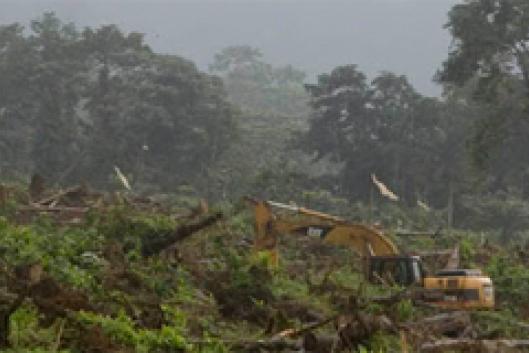São Tomé and Príncipe is one of the countries on the West African coast that stands out when it comes to biodiversity. For this reason, since the end of the 19th century these “beautiful equatorial islands” have attracted enormous interest from international researchers.Their forests have been classified as one of the two hundred most important areas in the world in terms of biodiversity. They are the habitat for around 25 species of endemic birds.
Portuguese biologist João Pedro Pio went to southwestern São Tomé in July 2012. His intention was to find birds and other rare species in danger of extinction, as is the case for the Ibis, which is at the top of the list as one of the critically endangered endemic birds.
The blog Apenas a minha história (Just my story), where João Pedro tells his experiences over the course of a year as a foreigner and researcher in São Tomé, describes the scene of devastation he found in the area:
“Well, when the transect started, in an area that used to be closed forest, it became a muddy clearing. There were already no trees at all! They had all been cut down indiscriminately (…) with the exception of one or two Viru-vermelho remaining comically alone in the middle of all that destruction, there wasn't a single tree standing.
“In the distance a bulldozer works ruthlessly while the whole landscape seems to cry at the destruction.”
Ribeira Peixe, also called Emolve (after the vegetable oil company), was a large semi-abandoned oil palm plantation, a monoculture that always presented a danger to the island's biodiversity. Now the danger is aggravated by plans to rehabilitate and expand the plantation from the current 610 hectares to approximately 5,000 hectares, a fact confirmed in 2009 when the São Tomean State signed an agreement with Belgian company Socfinco for palm oil operation.
The researcher wrote that “the Government decided that it would be more profitable for the country to swap all its biodiversity, which is unique in the world, for a few tons of oil”.
The São Tomé and Príncipe Government signed a contract with Socfinco’s subsidiary Agripalma giving them 5000 ha. In other words, enough land so that the business of selling palm oil would become cost-effective.
The former International Coordinator of the World Rainforest Movement, Ricardo Carerre, in the report titled “Oil palm in Africa: Past, present and future scenarios” (http://wrm.org.uy/countries/Africa/Oil_Palm_in_Africa_map.html) explained the processes that led to the 50 - 75 million dollar deal in exchange for priceless riches.
These palm plantations aggressively degrade the environment, absorbing the soil's nutrients and leaving it extremely poor until, in less than two decades, it becomes totally barren land, serving only for scrub growth, which is perfect fuel for fires. Furthermore, the factories that emerge to process this oil typically produce a large amount of contaminating waste, represented by husks, water and fat residues and, as it is presumably a monoculture, it will need a large amount of herbicides, fertilizers and pesticides.
There is the saying “learn from others' mistakes”, and the benefit of history is that we can learn to not make the same mistake. In Indonesia and Malaysia, for example, entire forests have disappeared with palm oil operations. Close to two million hectares of forest are destroyed annually and the exploitation in question only seems to benefit large farming operations and corrupt governments.
Summary of the article “São Tomé & Príncipe: Deforestation Threatens Biodiversity”by Mário Lopes, sent by the author. The full article can be read at http://globalvoicesonline.org/2012/10/13/sao-tome-principe-deforestation-threatens-biodiversity/
